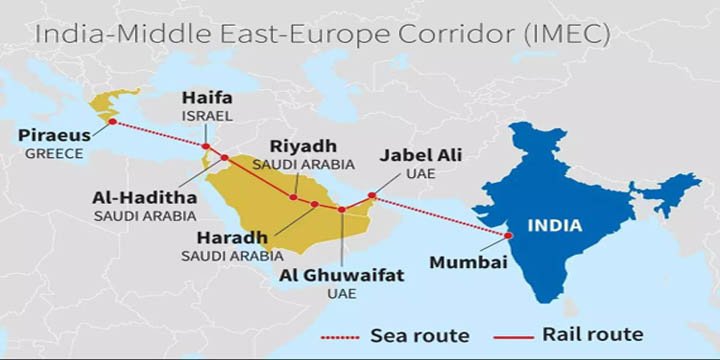IMEC CORRIDOR & ITS IMPLICATIONS
- Gaza Ceasefire and IMEC’s Revival: US President Joe Biden recently commented that with the ceasefire deal between Israel and Hamas, the IMEC Corridor could finally become a reality.
- Biden highlighted how the project could transform global connectivity and regional economies.
- Impact of the Ceasefire: The IMEC project faced delays after the Hamas attack on Israel in October 2023, which caused instability in the region.
- With the ceasefire, the project can now move forward without such geopolitical hurdles.
WHAT IS IMEC?
- The India-Middle East-Europe Economic Corridor (IMEC) is a large-scale infrastructure project designed to connect India, the Middle East, and Europe through a network of ports, railways, roads, sea routes, and pipelines.
- This initiative aims to improve trade, connectivity, and cooperation among these regions.
- Participants: The project was officially announced during the G20 summit in New Delhi on September 9, 2023.
- The agreement was signed by India, the United States, Saudi Arabia, the UAE, France, Germany, Italy, and the European Union.
STRATEGIC IMPORTANCE OF IMEC
- Global Trade and Connectivity: IMEC aims to significantly enhance trade routes between Asia, the Middle East, and Europe, making trade faster, cheaper, and more efficient.
- Alternative to China’s OBOR: The IMEC Corridor is seen as a counter to China’s Belt and Road Initiative (BRI).
- Unlike BRI, which focuses on Chinese interests, IMEC provides a platform for regional cooperation, infrastructure development, and a more balanced trade network.
- India’s Growing Role: For India, this project is a key step in positioning itself as a global leader in trade and infrastructure development. It also boosts India’s strategic presence in Middle Eastern and European
KEY FEATURES
- Rail and Shipping Routes:
- The IMEC will feature cross-border railways connecting India to the Arabian Gulf and then linking the Gulf to Europe.
- A shipping route will connect the Indian ports of Mumbai and Mundra to the UAE, with rail links extending to Israel’s Haifa port and onward to Greece and Europe.
- Infrastructure:
- Energy: IMEC will include hydrogen gas pipelines and electricity grids to enhance energy security across regions.
- Digital Connectivity: The project also plans to lay fiber-optic cables to boost digital infrastructure and improve communication.
- Efficiency: The corridor aims to make the trade process more cost-effective and reliable, improving regional supply chains and boosting economic activity in the participating countries.
THE IMEC PROJECT’S BENEFITS
- Economic Cooperation: IMEC will lead to greater economic cooperation between India, the Middle East, and Europe, helping countries involved to strengthen their trade ties and open up new markets for goods and services.
- Job Creation and Economic Growth: By improving trade routes and infrastructure, the IMEC is expected to generate jobs and promote sustainable economic development in the participating regions.
- Sustainability: The project also focuses on reducing greenhouse gas emissions by providing more efficient transport options and supporting clean energy initiatives like hydrogen gas transport and renewable electricity.
- Secure Trade Routes: The development of IMEC aims to secure regional supply chains, reduce transportation costs, and ensure reliable trade routes that will be critical for future economic stability.
ROLE OF INDIA IN IMEC
- Key Player: India is at the heart of the IMEC initiative, both geographically and strategically. As the starting point of the corridor, India’s involvement ensures it will play a central role in reshaping global trade routes and positioning itself as a major economic and diplomatic
- Strengthening Regional Ties: India’s active participation in the project also strengthens its ties with both the Middle East and Europe, making it a critical partner in regional and global economic development.
CHALLENGES & ROADBLOCKS
- Geopolitical Tensions: While the ceasefire between Israel and Hamas is a positive development, tensions in the Middle East remain high. Conflicts or instability in the region could still delay or hinder progress on the project.
- China’s Response: China’s Belt and Road Initiative (BRI) remains a major competitor to the IMEC. The Chinese government has already invested in several infrastructure projects in Asia and Africa, and its reaction to the IMEC may influence the global response to the project.
- Regional Cooperation: The success of IMEC will depend on continued collaboration and cooperation among the countries involved. Any breakdown in communication or disagreements over project details could delay progress.
IMEC’S BROADER IMPLICATIONS
- Shaping Future Global Trade: The IMEC project is poised to reshape how goods move between Asia, the Middle East, and Europe, bringing more efficiency and stability to global supply chains.
- Strategic Influence: For countries like India, the IMEC is a strategic tool that increases their global influence in geopolitical and economic
- Alternative Growth Model: By focusing on regional collaboration and sustainable infrastructure, IMEC offers an alternative to China’s One Belt, One Road (BRI), which is often criticized for its debt-trap diplomacy and its heavy focus on Chinese interests.
Note: Connect with Vajirao & Reddy Institute to keep yourself updated with latest UPSC Current Affairs in English.
Note: We upload Current Affairs Except Sunday.


